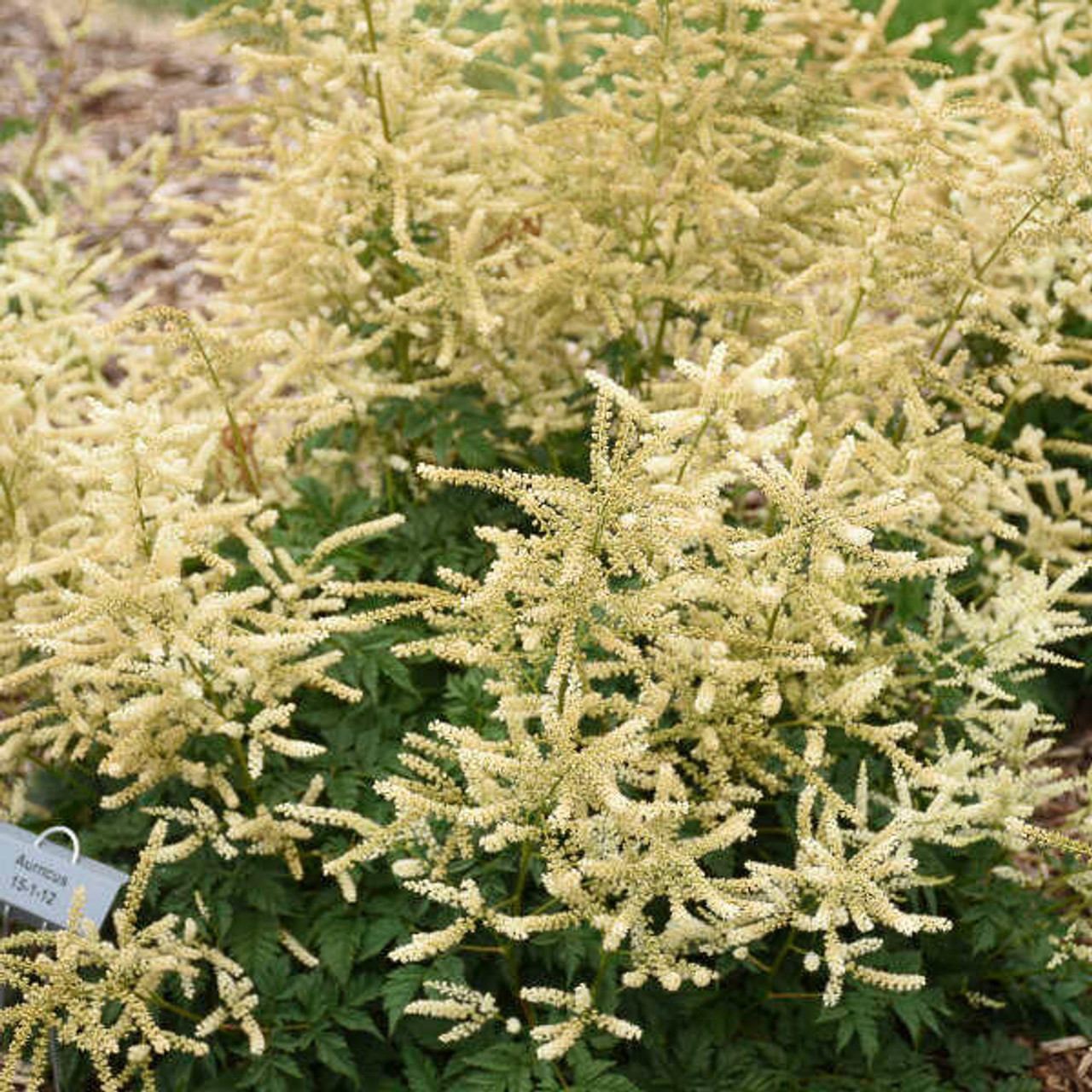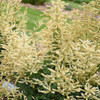Product Description
Aruncus 'Goatee' PPAF (30)ct Flat
Common Name: Goat's Beard
This finely textured Aruncus hybrid is flower powered! Extremely floriferous for a Goat's Beard, 'Goatee' springs to life with clouds of dense cream flower panicles in early summer. Dissected dark green leaves provide interest before and after bloom. This perennial tolerates a variety of light conditions, going full sun to full shade. More moisture will be needed to keep 'Goatee' looking its best in full sun; plants will be slightly taller in shade.
Though Aruncus tends to be a slow-grower the first couple of seasons, once it is established it puts on a fabulous show year after year. Make sure it has plenty of room to grow when you first plant it; transplanting this species is a very difficult task. This species is native to North America.
Goat's Beard grows best in moist, humus-rich soils. In northern climates, it can be grown in full sun if provided with adequate moisture. In southern zones, however, it prefers partial or full shade. When grown in deep shade, plants tend to have a more open habit and bloom sparsely. Insects and diseases don't seem to bother this plant.
Height: 24.0-26.0 Inches
Spread: 26.0-28.0 Inches
Hardiness Zones: 3,4,5,6,7
Flower Color: White Shades
Foliage Color: Green shades
Full Sun (> 6 hrs. Direct Sun) to Full Shade (< 4 hrs. Direct Sun)
Average to Consistent Water Needs
Fertile Soil Quality
Bloomtime: Early Summer to Midsummer
Bee Friendly
Deer Resistant
Growth Rate: Medium
Border Plant, Container, Cut Flower, Cut Foliage, Mass Planting
Aruncus 'Goatee' is a charming and versatile perennial that adds a touch of elegance to any garden. Here is a rundown of what makes it special:
What Makes Aruncus 'Goatee' Special
- Unique Flower Structure: The creamy white flowers are arranged in dense, plume-like panicles that resemble a goat's beard, hence the name. These blooms appear in late spring to early summer, creating a lovely display.
- Attractive Foliage: The dark green leaves are deeply divided and lacy, providing textural interest even when the plant is not in bloom.
- Adaptable: It thrives in a variety of light conditions, from full sun to full shade, making it a versatile choice for different garden settings.
- Drought Tolerant (Once Established): Unlike some other moisture-loving plants, 'Goatee' has good drought tolerance once it is established.
- Deer Resistant: It is generally avoided by deer, which is a bonus for gardeners in areas with deer pressure.
- Long-Lived and Carefree: Once established, it is a low-maintenance plant that will provide years of enjoyment.
Description and Details
- Common Name: Goatee Goat's Beard
- Botanical Name: Aruncus 'Goatee'
- Mature Size: 24-26 inches tall, 26-28 inches wide
- Foliage: Dark green, finely divided leaves
- Flowers: Creamy white plumes in late spring to early summer
- Growth Habit: Upright, mounding
- Hardiness Zones: 3-7
- Light: Full sun to full shade (more moisture needed in full sun)
- Soil: Moist, well-drained
- Water: Water regularly until established, then as needed during dry periods
Landscaping Design Tips
- Woodland Gardens: It's a natural choice for woodland gardens, where its airy flowers and textured foliage complement the dappled shade and other woodland plants.
- Shade Gardens: It brightens up shady areas with its white blooms and contrasting foliage.
- Mixed Borders: It adds vertical interest and a touch of elegance to mixed borders.
- Container Gardening: It can be grown in containers, especially in shady locations.
- Mass Plantings: Plant it in groups or masses for a more dramatic effect.
- Companion Plants: Consider pairing them with other shade-loving plants such as:
- Hostas
- Ferns
- Astilbes
- Bleeding Hearts
- Columbines
Planting and Care
- Planting:
- Choose a location with moist, well-drained soil.
- Plant in spring or fall.
- Space plants according to their mature size (about 2-3 feet apart).
- Water thoroughly after planting.
- Care:
- Water regularly, especially during dry periods.
- Fertilize lightly in spring if desired.
- Deadhead spent flowers to encourage reblooming.
- Divide clumps every few years to prevent overcrowding and rejuvenate the plant.
Additional Notes
- 'Goatee' is a relatively compact Aruncus, making it a good choice for smaller gardens.
- It is a great alternative to Astilbe for gardeners looking for something more drought-tolerant.
- The flowers attract pollinators such as bees and butterflies.
Thirty (30) plants per flat (or tray). Approximate Plug Measurements: 3 inches deep x 2 inches wide.
Other Details
The most important part of the plant is its root system. Healthy roots are the foundation of a healthy, vibrant plant. The type of plug container used is based on the specific needs of the plants. Perennials offered as bare root traditionally perform better when planted as bare root.Planted in a specialized mix, potted plants have well established root systems. Top growth stage will vary depending on the current life cycle and time of year when shipped. In Winter and early Spring dormant plants may be shipped. Dormant plants may be planted right away, even before the last frost date.
Most bare root varieties are field grown for at least one season, though Hemerocallis and Hosta are grown for two seasons. The bulk of the soil is removed during the harvesting process and the tops of most varieties are trimmed back to the crown. They are graded, packed in shredded aspen or sphagnum moss and stored in freezers until ready to be shipped.
See our Container Sizes and Bare Root Perennials pages for more information.
Plant information and care is provided in the Overview section, Plant Genus Page and general information is provided in the Planting Care & Guides. Additional questions can be asked on each Plant page.
Plant Spacing: Using the maximum mature spread or width of a plant to guide spacing, ensures space to grow to full size. To fill an area sooner, plant them closer together. Just remember, future thinning or transplanting may be needed.
Water: Keep a close eye on newly planted perennials, especially throughout the first growing year. Most early plant loss is due to too much or too little water!












